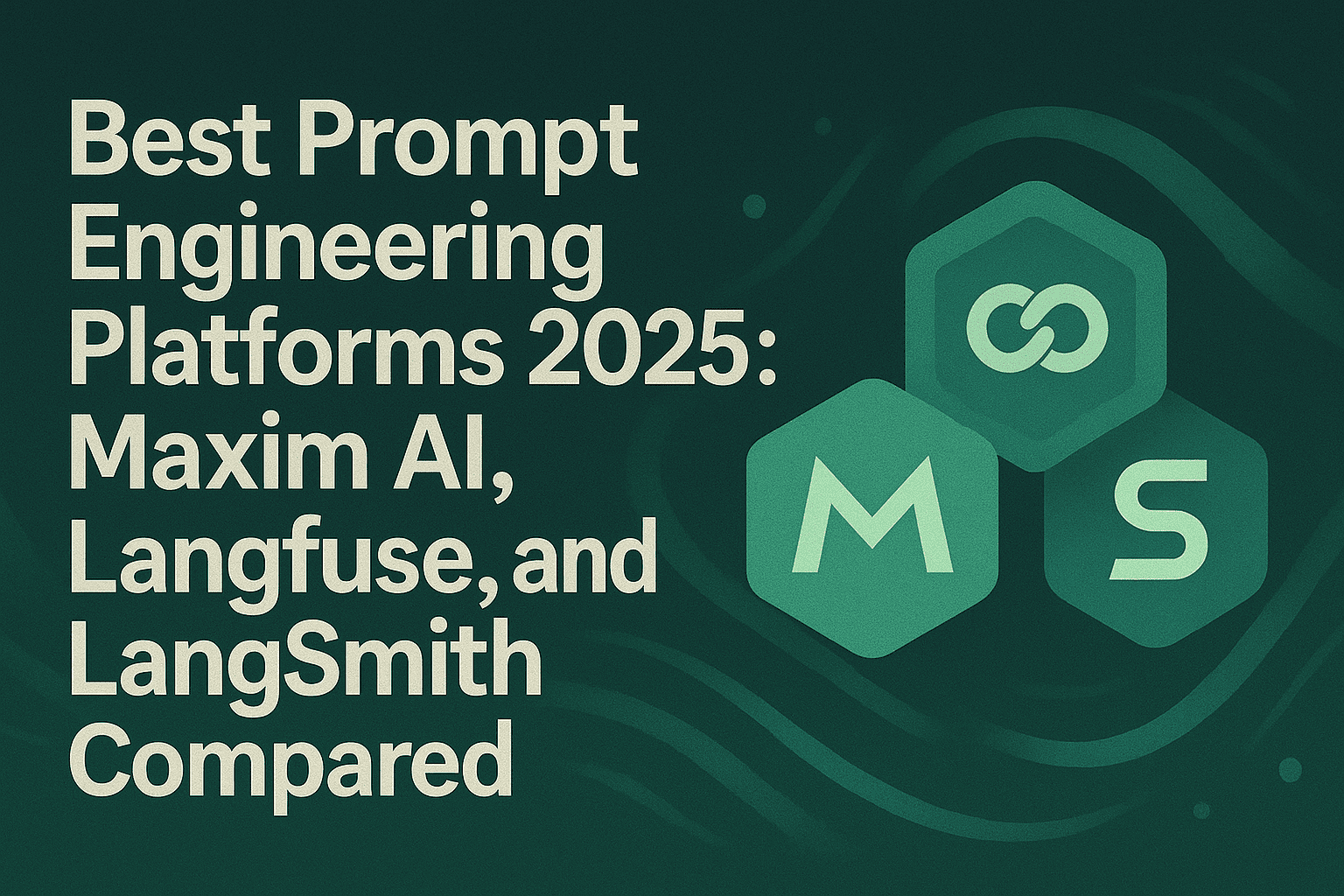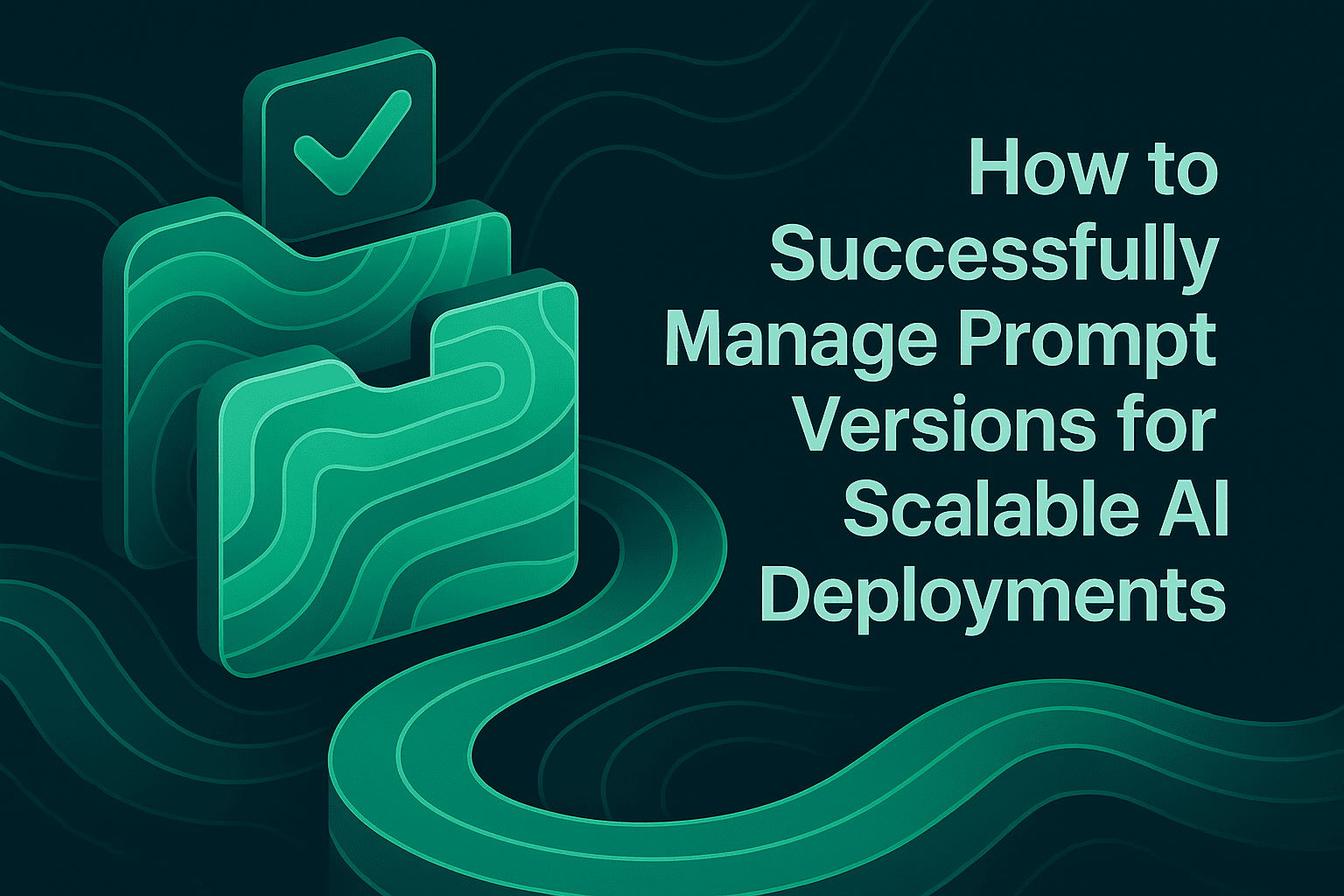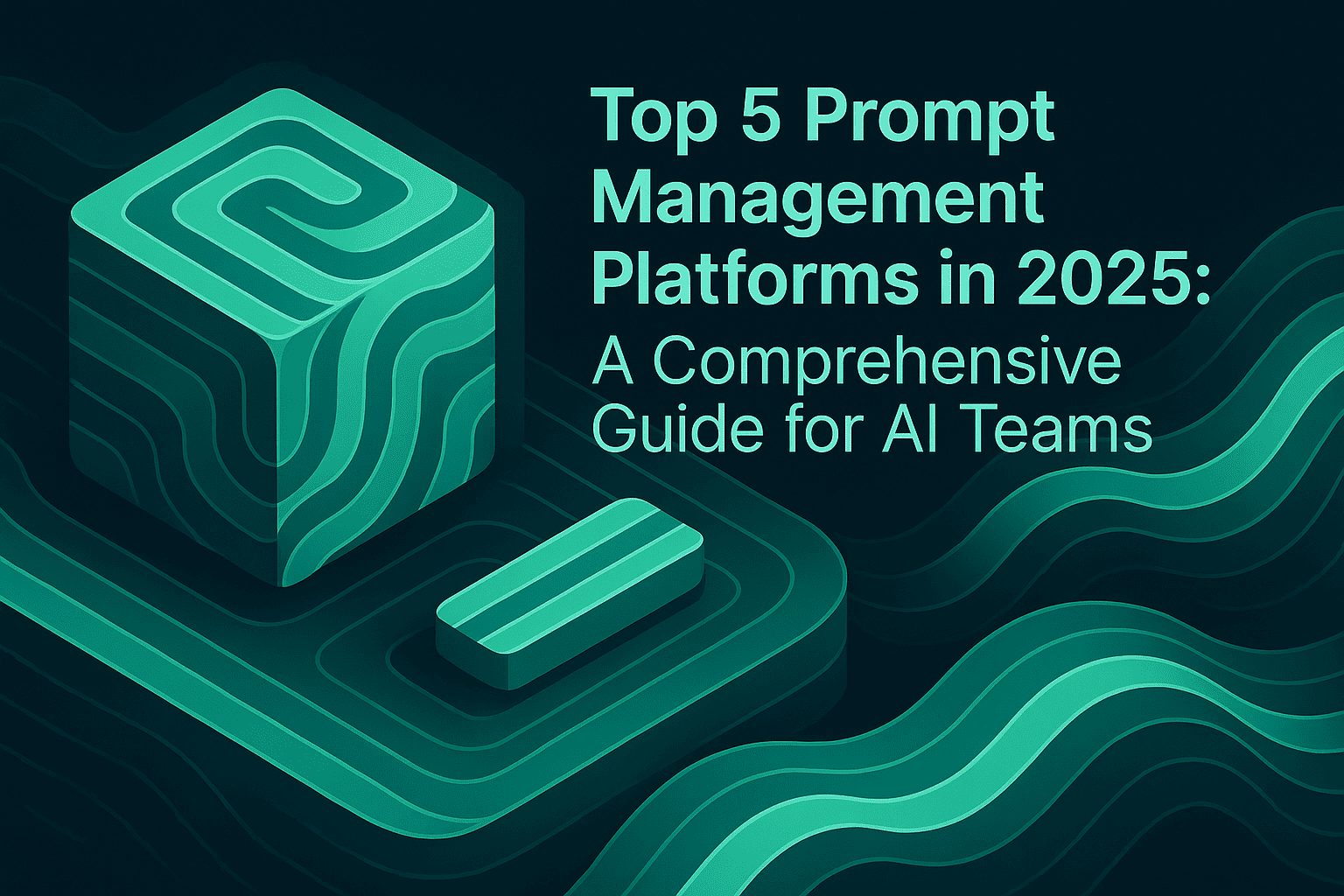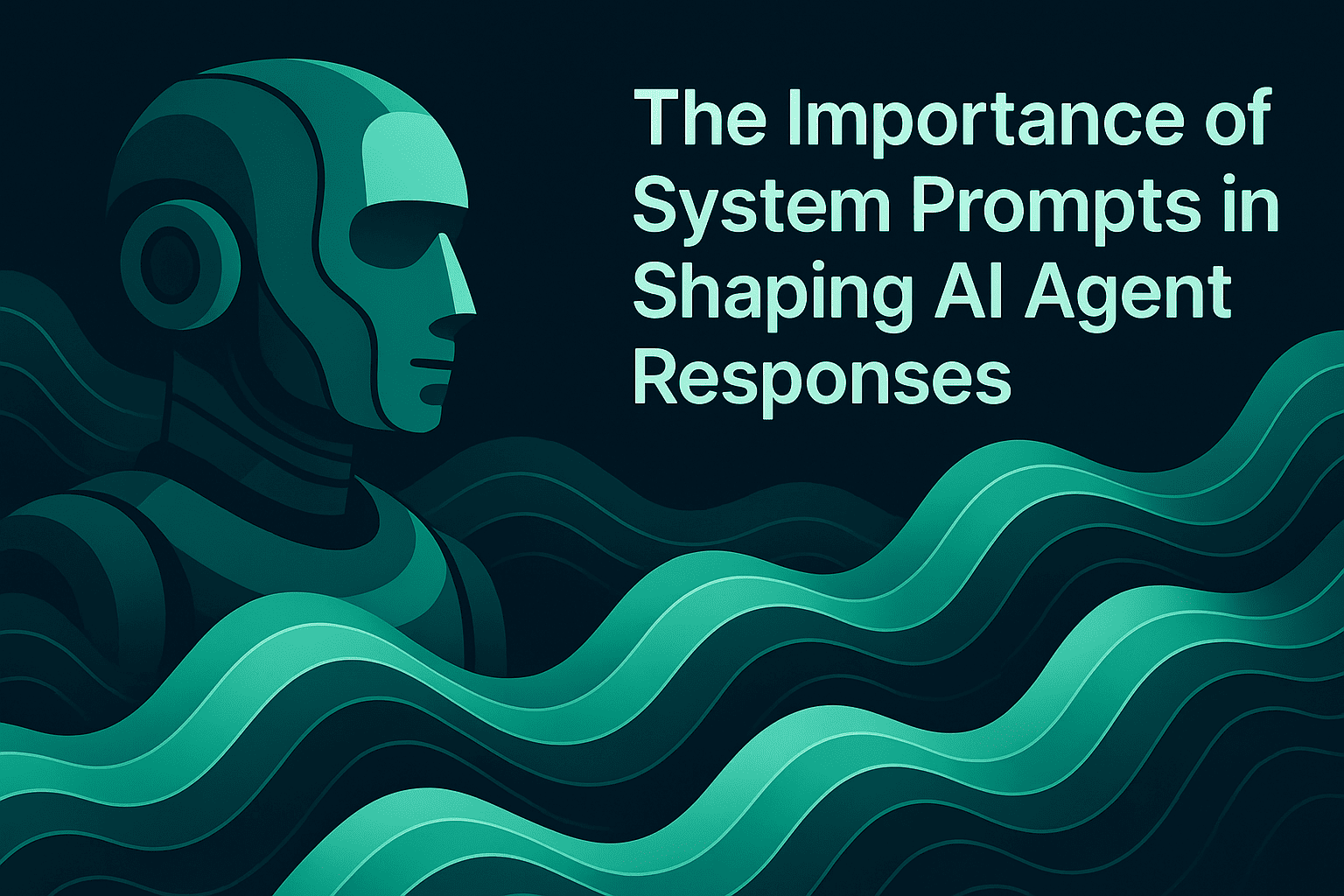Best Prompt Engineering Platforms 2025: Maxim AI, Langfuse, and LangSmith Compared

Prompt engineering has evolved from a niche skill into a critical capability for AI teams building production-grade applications. As organizations deploy increasingly complex AI agents and LLM-powered workflows, the need for robust platforms that support systematic prompt development, testing, and optimization has become essential. In 2025, teams require more than basic prompt playgrounds, they need comprehensive solutions that span the entire AI development lifecycle, from experimentation to production monitoring.
This article examines three leading prompt engineering platforms in 2025: Maxim AI, Langfuse, and LangSmith. Each platform offers distinct approaches to solving the challenges of modern prompt engineering, catering to different team needs and technical requirements. Understanding the capabilities, strengths, and ideal use cases for each platform enables engineering and product teams to select the solution that best aligns with their AI development objectives.
The Evolution of Prompt Engineering Platforms
Prompt engineering has transformed significantly since the early days of LLM applications. In 2025, prompt engineering tools go beyond text to support multimodal capabilities, integration with multiple AI models, and collaboration features that make prompt development scalable for entire teams. The sophistication of modern AI applications (including multi-agent systems, tool-augmented workflows, and retrieval-augmented generation pipelines) demands platforms that can handle complexity at scale.
Today's prompt engineering platforms must address several critical requirements: support for multiple LLM providers, robust version control and collaboration features, comprehensive evaluation frameworks, production observability, and enterprise-grade security. According to recent industry analysis, prompt engineering apps help coax better performance from AI, with functionality spanning supported AI models, collaboration tools, and pricing options becoming key differentiators.
The shift from individual prompt crafting to team-based AI development has fundamentally changed platform requirements. Cross-functional teams (including AI engineers, product managers, QA professionals, and domain experts) now collaborate on prompt optimization, requiring platforms that accommodate both technical and non-technical users while maintaining rigorous quality standards.
1: Maxim AI - Comprehensive AI Lifecycle Management
Maxim AI represents an end-to-end approach to prompt engineering and AI quality management. The platform addresses every stage of the AI development lifecycle, from initial experimentation through production deployment and monitoring. Maxim AI is a platform for systematic evaluation and benchmarking, combining automated metrics with human feedback for better quality control.
Core Capabilities and Features
Maxim AI's Experimentation platform provides advanced prompt engineering capabilities through its Playground++ environment. Teams can rapidly iterate on prompts, test different model configurations, and deploy changes without code modifications. The platform supports prompt versioning directly from the UI, enabling collaborative prompt development across engineering and product teams.
The Agent Simulation and Evaluation capabilities distinguish Maxim from traditional prompt management tools. Teams can simulate customer interactions across real-world scenarios and user personas, monitoring how agents respond at every conversational step. This simulation-first approach enables proactive quality assurance before production deployment, reducing the risk of unexpected agent behavior in live environments.
Maxim's unified evaluation framework supports both automated and human-in-the-loop assessments. The platform provides access to off-the-shelf evaluators through its evaluator store while enabling teams to create custom evaluators tailored to specific application requirements. Maxim's platform makes it seamless to set up and scale human-in-the-loop evaluation workflows with a few clicks, with dedicated support for human evaluations on Enterprise plans.
Production Observability and Monitoring
The Observability suite empowers teams to monitor real-time production logs and conduct periodic quality checks. Distributed tracing capabilities enable developers to track, debug, and resolve live quality issues, with real-time alerts that minimize user impact. Multiple repositories can be created for different applications, facilitating organized logging and analysis across an organization's AI portfolio.
In-production quality measurement occurs through automated evaluations based on custom rules, ensuring continuous monitoring of agent performance. The data curation features enable teams to build high-quality datasets from production logs, supporting ongoing evaluation and fine-tuning efforts. This closed-loop approach connects production insights directly to development workflows, accelerating iteration cycles.
Cross-Functional Collaboration
Maxim's design philosophy centers on cross-functional collaboration between engineering and product teams. While Maxim provides powerful SDKs in Python, TypeScript, Java, and Go, the entire evaluation workflow is accessible through a no-code, intuitive UI, enabling product managers to define, run, and analyze evaluations independently without waiting on engineering.
This accessibility extends to prompt engineering workflows. Domain experts can iterate on prompts, configure evaluations, and analyze results without deep technical knowledge, while engineers maintain control over infrastructure and integration. The platform's approach reduces bottlenecks in AI development cycles, enabling faster experimentation and deployment.
Enterprise-Grade Features
Maxim supports enterprise requirements with SOC 2 Type 2 compliance, in-VPC deployment options, custom SSO integration, and role-based access controls. These features ensure that organizations can maintain security and compliance standards while scaling AI development across teams. The platform's data management capabilities include multi-modal dataset support, enabling teams to work with text, images, and other content types within a unified environment.
2: Langfuse - Open-Source LLM Engineering
Langfuse positions itself as an open-source platform supporting every stage of developing, monitoring, evaluating, and debugging LLM applications. Langfuse is an open-source platform that supports every stage of developing, monitoring, evaluating, and debugging LLM applications, with developers able to monitor LLM outputs in real time.
Core Architecture and Approach
Langfuse's open-source foundation appeals to teams seeking transparency and customization flexibility. The platform provides comprehensive tracking of LLM calls, inputs, outputs, and intermediate steps, giving developers full visibility into application behavior. This tracing capability proves particularly valuable for debugging complex chains and understanding precisely how models process prompts at each step.
The platform supports both user feedback collection and automated evaluation methods to assess response quality. Teams can gather real-time feedback from users while implementing programmatic quality checks, creating a comprehensive view of model performance. This dual approach enables continuous improvement driven by both quantitative metrics and qualitative user insights.
Structured Testing for AI Agents
Langfuse provides structured testing capabilities specifically designed for AI agents in chat-based interactions. The unit testing features help developers ensure the reliability and consistency of their AI agents, making sure that everything works as expected. These testing tools enable teams to validate agent behavior across different scenarios, catching potential issues before they reach production environments.
The platform's evaluation framework includes pre-built evaluators for common tasks and supports custom evaluation logic. Teams can define specific quality criteria aligned with their application requirements, implementing rigorous testing protocols that reflect real-world usage patterns.
Open-Source Benefits and Considerations
The open-source nature of Langfuse provides several advantages. Teams gain full transparency into platform functionality, enabling deep customization and integration with existing tooling. Organizations with strong engineering resources can self-host Langfuse, maintaining complete control over deployment, data, and security configurations.
However, the open-source model also presents considerations. Teams must invest engineering resources in deployment, maintenance, and customization. While this approach offers maximum flexibility, it requires technical expertise and ongoing effort to maintain and scale the platform as application complexity grows.
Framework Integration
Langfuse integrates with popular AI development frameworks, supporting teams that have already invested in specific technology stacks. The platform's compatibility with common orchestration tools enables seamless adoption without requiring wholesale changes to existing development workflows.
3: LangSmith - LangChain Ecosystem Integration
LangSmith serves as the companion platform to LangChain, focusing on monitoring, debugging, and evaluation for LLM applications. LangSmith is a companion to LangChain that adds monitoring, debugging, and evaluation to LLM apps, ensuring workflows run smoothly in production.
Comprehensive Request Tracking
LangSmith records all LLM calls, inputs, and outputs, and intermediate steps into a trace that developers can inspect, providing full visibility into the chain of calls and helping developers see exactly what the model was asked and how it responded at each step. This detailed tracing capability enables precise debugging of complex workflows, particularly valuable for applications built using LangChain's orchestration framework.
The platform's tracking information captures the entire sequence of prompts, model responses, and tool invocations. When workflows behave unexpectedly, developers can examine each step in detail, identifying exactly where issues occur and understanding the context that led to specific model behaviors.
Evaluation Framework
LangSmith provides integrated capabilities for creating datasets of test queries and expected answers, enabling systematic evaluation of model performance. Using the LangSmith SDK or UI, teams can easily build high-quality LLM evaluation sets and run them in bulk, with a suite of off-the-shelf evaluators and support for custom ones to automatically grade or score LLM responses.
The evaluation workflow supports rapid iteration on prompts and chains. Teams can define comprehensive test suites that represent diverse use cases, then evaluate different prompt variations against these benchmarks. This systematic approach transforms prompt optimization from guesswork into a data-driven process with measurable outcomes.
LangChain Ecosystem Benefits
For teams already invested in the LangChain ecosystem, LangSmith offers seamless integration with familiar development patterns. The platform extends LangChain's capabilities with production-grade observability and testing features, creating a cohesive development experience from prototyping through production deployment.
This tight integration reduces friction in adoption. Developers familiar with LangChain can leverage existing knowledge while gaining access to robust monitoring and evaluation capabilities. The platform's design reflects deep understanding of LangChain workflows, optimizing specifically for common patterns and challenges in chain-based LLM applications.
Debugging and Optimization
LangSmith excels in scenarios requiring detailed debugging of multi-step AI processes. The visualization of chain execution provides clear insights into how prompts flow through complex workflows, where bottlenecks occur, and how different components interact. For teams managing sophisticated agent architectures with multiple decision points and tool calls, these debugging capabilities prove invaluable.
The platform enables developers to optimize long-running workflows by identifying performance bottlenecks and evaluating the impact of changes to specific chain components. This granular control supports iterative refinement of agent behavior, ensuring that optimizations align with actual performance data rather than assumptions.
Comparative Analysis: Choosing the Right Platform
Selecting among these platforms requires understanding the specific needs of your AI development team and the characteristics of your applications.
When to Choose Maxim AI
Maxim AI suits teams building production-grade agentic systems with complex, multi-step interactions. Organizations requiring comprehensive end-to-end lifecycle management (spanning experimentation, simulation, evaluation, and observability) will benefit from Maxim's unified platform approach. Maxim AI offers a unified platform covering the entire agent lifecycle from prompt engineering and simulation to live production monitoring, reducing the need for stitching together multiple tools.
The platform particularly excels for cross-functional teams where product managers and domain experts need to actively participate in prompt engineering and evaluation. Maxim's no-code UI enables non-technical stakeholders to contribute meaningfully while maintaining rigorous quality standards. Teams prioritizing collaboration between engineering and product functions will find Maxim's design philosophy aligned with modern AI development practices.
Enterprise organizations with compliance requirements, security needs, and multiple teams developing AI applications benefit from Maxim's governance features. The platform's SOC 2 Type 2 certification, role-based access controls, and in-VPC deployment options address enterprise security concerns while supporting scalable development processes.
Start your free trial with Maxim AI to experience comprehensive AI lifecycle management.
When to Choose Langfuse
Langfuse proves ideal for teams prioritizing open-source solutions and requiring maximum customization flexibility. Organizations with strong engineering capabilities that want complete control over deployment, data handling, and platform modifications will appreciate Langfuse's transparent architecture.
The platform suits teams in early to mid-stage development who need robust monitoring and evaluation capabilities without the overhead of comprehensive agent simulation infrastructure. Langfuse provides essential observability and testing features while maintaining a focused scope, making it accessible for teams ramping up AI development practices.
Teams with specific integration requirements or unique technical constraints benefit from Langfuse's extensibility. The ability to modify source code and customize functionality enables solutions tailored precisely to organizational needs, though this requires investment in engineering resources.
When to Choose LangSmith
LangSmith represents the optimal choice for teams deeply invested in the LangChain ecosystem. Organizations that have standardized on LangChain for agent orchestration gain immediate value from LangSmith's purpose-built debugging and monitoring capabilities.
The platform excels for use cases involving complex, multi-step chains where understanding execution flow and debugging unexpected behaviors are paramount. LangSmith's detailed tracing and visualization tools provide unmatched insight into chain-based architectures, accelerating troubleshooting and optimization efforts.
Teams in prototyping or early production stages who need quick setup and immediate debugging capabilities will appreciate LangSmith's developer-focused design. The platform enables rapid experimentation with different chain configurations while maintaining visibility into performance and behavior.
Key Considerations for Platform Selection
Several factors should guide platform selection beyond feature comparisons:
Team Composition: Consider whether your team includes non-technical stakeholders who need to participate in prompt engineering and evaluation. Platforms with robust no-code interfaces enable broader participation, while technically-focused platforms may better suit engineering-centric teams.
Application Complexity: Simple LLM applications with straightforward prompt-response patterns have different platform requirements than complex multi-agent systems with tool usage, memory management, and multi-turn conversations. Match platform sophistication to application complexity.
Development Stage: Early-stage experimentation benefits from lightweight, flexible tools that support rapid iteration. Production deployments require robust observability, compliance features, and enterprise-grade security. Some platforms span this spectrum more comprehensively than others.
Integration Requirements: Evaluate how platforms integrate with your existing technology stack. Consider compatibility with your chosen LLM providers, orchestration frameworks, CI/CD pipelines, and data infrastructure. Seamless integration reduces friction and accelerates adoption.
Budget and Resources: Open-source platforms require engineering investment in deployment and maintenance but avoid licensing costs. Commercial platforms provide managed services and support but involve ongoing expenses. Balance total cost of ownership against team capacity and organizational priorities.
The Future of Prompt Engineering Platforms
The prompt engineering landscape continues to evolve rapidly. Several trends are shaping platform development in 2025 and beyond:
Multimodal Capabilities: Platforms increasingly support images, audio, and video alongside text, reflecting the multimodal nature of modern AI applications. Comprehensive platforms enable teams to work with diverse content types within unified workflows.
Automated Optimization: AI-powered prompt optimization and automated testing reduce manual iteration cycles. Today's prompt engineering platforms leverage AI to provide intelligent prompt suggestions and automated optimization, eliminating much of the trial-and-error involved in crafting effective prompts.
Enhanced Collaboration: Platform designs increasingly recognize that AI development involves cross-functional teams. Tools that bridge technical and non-technical roles enable more effective collaboration and faster innovation cycles.
Security and Compliance: As AI applications enter regulated industries, platforms must provide robust security features, audit capabilities, and compliance certifications. Enterprise adoption depends on platforms meeting stringent organizational requirements.
Production-First Design: The shift from experimental projects to production deployments drives demand for platforms emphasizing observability, reliability, and operational excellence alongside development features.
Best Practices for Platform Adoption
Successful platform adoption requires more than selecting the right tool. Consider these practices when implementing prompt engineering platforms:
Start with Clear Objectives: Define specific goals for platform adoption. Whether improving prompt quality, accelerating development cycles, or ensuring production reliability, clear objectives guide effective platform utilization and measure success.
Invest in Team Training: Platform capabilities only deliver value when teams understand how to use them effectively. Allocate time for training, documentation review, and hands-on experimentation. Develop internal expertise that can guide broader adoption.
Establish Evaluation Standards: Define quality metrics and evaluation criteria aligned with application requirements. Implement systematic testing protocols that reflect real-world usage patterns. Consistent evaluation standards enable objective assessment of prompt improvements.
Build Iterative Workflows: Create development processes that leverage platform capabilities for rapid iteration. Establish feedback loops connecting production insights to development workflows, enabling continuous improvement driven by actual performance data.
Monitor and Optimize: Use platform observability features to track performance in production. Establish alerts for quality degradation and implement regular reviews of agent behavior. Proactive monitoring prevents issues from impacting users and identifies optimization opportunities.
Conclusion
The choice of prompt engineering platform significantly impacts AI development velocity, application quality, and team collaboration. Maxim AI, Langfuse, and LangSmith each offer distinct value propositions suited to different organizational needs and development contexts.
Maxim AI provides comprehensive lifecycle management spanning experimentation, simulation, evaluation, and observability, with strong emphasis on cross-functional collaboration and enterprise requirements. The platform enables teams to manage complex AI applications through unified workflows that connect development and production.
Langfuse offers open-source flexibility and customization for teams with strong engineering capabilities seeking maximum control over their AI development infrastructure. The platform provides essential monitoring and evaluation features with transparency and extensibility.
LangSmith delivers purpose-built debugging and monitoring for LangChain-based applications, offering deep integration with a popular orchestration framework. The platform excels at providing visibility into complex chain execution and supporting rapid iteration on chain configurations.
As AI applications grow in sophistication and business criticality, the importance of robust prompt engineering platforms increases correspondingly. Organizations that invest in comprehensive tooling, establish systematic development practices, and foster cross-functional collaboration position themselves to build reliable, high-quality AI applications at scale.
The platforms examined in this article represent the current state of prompt engineering tools in 2025, each contributing to the maturation of AI development practices. By understanding their capabilities, strengths, and ideal use cases, teams can select solutions aligned with their specific requirements and successfully navigate the complexities of modern AI application development.
Explore how Maxim AI can accelerate your AI development and transform your team's approach to building reliable AI agents.


